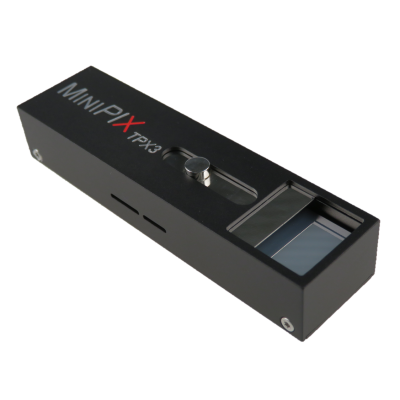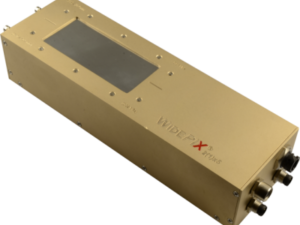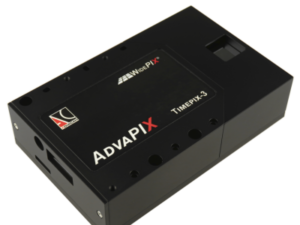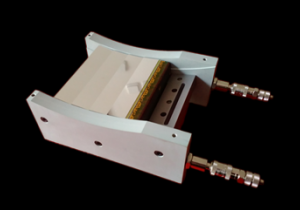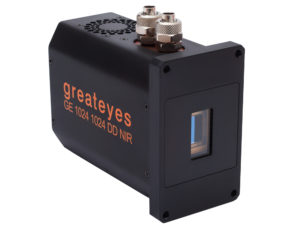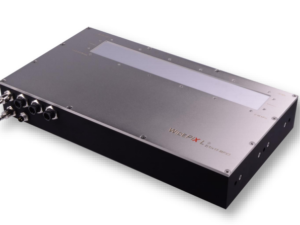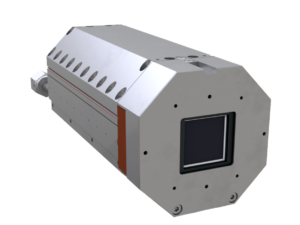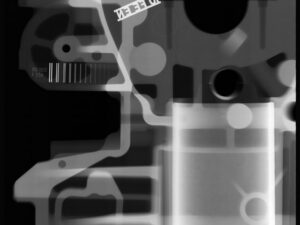Description
The MiniPIX TPX3 Small USB Camera module contains CERN’s latest Timepix3 detector, which is position, energy and time sensitive. For each ionizing particle it digitally registers its position, energy, time of arrival and track shape. The other measures can be often calculated from the track shape of the particle.
MiniPIX TPX3 Small USB Camera can be used in a variety of applications, such as spectral X-ray imaging (X-ray fluorescence imaging, X-ray radiography in low flux); energy dispersive XRD, SAXS or WAXS without monochromatic X-ray source; spectral gamma ray imaging (scintigraphy or SPECT, radiography with isotopes); radiation monitoring (particle type sorting, spectroscopy, directional sensitivity, etc); gamma camera with available special shielded box and collimators; and compton camera with available special software module for image reconstruction.
The Timepix3 detector has fast sparse data readout where each detected particle or photon is either read-out immediately (pixel mode) at maximal rate of 2.35 million hit pixels per second or accumulated in pair of images (frame mode) and read-out later at maximal speed of 16 frames per second. The device is controlled via USB2.0 interface with standard µUSB connector.
All major operating systems are supported (MS Windows, Mac OS and LINUX). The PIXET PRO software used for detector operation is provided for free. Extra software modules are available for special functions (e.g. coded aperture image reconstruction, Compton camera image and spectrum reconstruction, radiation field decomposition, networking of many devices, etc).
Key Features of MiniPIX TPX3 Small USB Camera:
- Sensor Material: Si or CdTe
- Sensor Thickness: 100 μm, 300 μm and 500 μm for Si; 1 mm CdTe
- Sensitive Area: 14 mm x 14 mm
- Time Resolution: 1.6 ns
- Readout Speed: 2.35 Million hits/s
- Frame rate: 16 fps
- Number of Pixels: 256 x 256
- Pixel Pitch: 55 μm
- Energy Resolution: 0.5-1 keV (Si) and 1.1-3.6 (CdTe)
- Min Detectable Energy: 3 keV (Si) and 5 keV (CdTe)
- Readout Chip: Timepix3
- Pixel Mode of Operation: Time-over-Threshold, Time-of -Arrival
- Connectivity: µUSB 2.0
- Weight: 30 g
- Dimensions: 80 mm x 21 mm x 14 mm
- Software: Pixet Pro
Click here for a data sheet
Non-Destructive Testing
Non-Destructive Testing (NDT) is inspection, test, or evaluation of materials, components or assemblies for discontinuities, or differences in characteristics without destroying the serviceability of the sample. Standard radiographic X-ray imaging provides a black and white intensity or density image of the inspected sample where defects, impurities or cracks are observed if the resolution and the signal over the noise of the image is appropriate. The spectral NDT X-ray imaging provides based on photon counting provides additional material information of the samples together with a superior contrast and high spatial resolution. The spectral material information is used to discriminate different materials that can be used to identify the materials of interest or to calculate their amount in the sample. Find out more about this application here.
Small Animal Spectral Imaging
Cancer research, bio-mechanics, and drug testing are just a few examples of where X-ray imaging contributes to research in biology and medicine. New photon counting detectors represent a serious advancement for these applications, compared to previously used synchrotrons. The energy sensitivity of modern cameras opens better possibilities to identify individual types of tissue. That has important consequences in various industries, for example cancer research, where the tumour tissue can be better distinguished from the healthy one.Find out more about this application here.
Art Authentication
Study and characterisation of art pieces, namely paintings, using X-ray imaging is becoming an increasingly important area. It is useful for galleries, museums and collectors to improve conservation and preservation methods. It is important for art buyers to reliably authenticate the works. The advanced X-ray imaging techniques provide detailed data for insurance companies to assess risks involved in transportation of art. The spectral imaging capability of Advacam’s detectors enables identification of different pigments based on their spectral responses. A “colour” X-ray image is then created where the colours are associated to different pigments identified in the painting. The recognition of pigments even in invisible lower layers can serve as an important clue in the process of art authentication.
Find out more about this application here.Mining and Geology
Resources mined from Earth fuel our society. However, efficient, eco-friendly mining is a must if we want to keep the economy and society sustainable. Cheap, fast exploration for mineral resources is required. Geology is a tool to understand our planet and also to help find resources still undiscovered. The energy sensitive photon counting detectors can help in this area thanks to the option of material identification in images. Drill cores from exploration bore holes can be now analysed in-situ identifying different minerals and providing immediate feedback for further exploration. Online monitoring of technological processes during mineral processing is another very important area where X-ray material resolved imaging plays an important role. It helps to increase efficiency of processing and reduce energy consumption leading not only to reduced costs, but also to lower environmental effects. Find out more about this application here.
X-ray Diffraction
X-ray diffraction is analytical method based on inspection of crystalline structure of samples used in applications, such as metallurgy, mineralogy, powders, pigments, polymers, surface layers and strain mapping. The traditional X-ray diffraction uses monochromatic X-rays which make the apparatus large and slow. ADVACAM’s spectral detectors based on Timepix3 chip with high resolution makes the diffraction system fast and compact. The sample analysis can be performed 100 times faster compared to the conventional systems. Due to fast speed of the analysis large areas of the sample can be analysed by scanning.
Find out more about this application here.
Other Applications
ADVACAM offers cameras and solutions for multiple other application such as electron microscopy, crystallography, neutron imaging, charged particle tracking and dosimetry for cancer therapy. In addition, number of cameras are being used in the basic research, such as at CERN’s LHC accelerator, and for education of radiation and its properties in schools and universities. Find out more about this here.
Advacam Technology
The leading detector technology, which Advacam uses for its products and solutions is based on Medipix hybrid pixel detectors. These devices were developed within international collaboration of universities and research laboratories lead by team at CERN during past 20 years. Advacam team’s members have been part of the Medipix Collaboration from it inception and have been contributing to the technology.
Photon Counting Technology
Advacam’s imaging cameras are direct conversion single photon counting pixel detectors that represent the cutting edge of current radiation imaging technology. The term “single photon counting” means that every single photon of X-ray radiation detected in individual pixel is processed and counted. The technology brings two major advantages in comparison to the conventional X-ray imaging – high contrast together with sharp images and spectral information of X-rays that allows material specific information to be displayed in colors.
In the direct conversion cameras each pixel of the semiconductor crystal is directly connected to the complex CMOS circuit using a conductive solder bump. In the indirect conversion cameras a scintillation layer is attached on top of a photodiode. The photodiodes manufactured on a simple CMOS circuit that enables fine pixel sizes.

Illustrative comparison of a single pixel of a direct conversion and indirect conversion cameras.
The term direct conversion refers to immediate conversion of the X-rays into electric charge within the semiconductor crystal. The principle is contrary to the conventional indirect conversion where the X-rays are first converted into visible light in the scintillation layer that subsequently is converted into electric charge in the photodiodes.

Illustration of the operation principles in a single pixel between the direct and indirect conversion cameras.
The photon counting principle of detection eliminates all other sources of noise that are present in CCD or flat-panel based cameras. This leads to considerably better signal-to-noise ratio and therefore detectability of more details in images. The images sharpness or the actual spatial resolution of the captured image is defined by the electric charge in the CMOS readout. Even thought the pixel size of of the direct converting cameras is larger than that of the conventional indirect conversion cameras, the signal of the detected X-rays is better focused into the pixels. The typical size of a direct conversion pixel ranges from few millimeters to tens of micro meters where Advacam represents the highest pixel density of the current industrial X-ray cameras with 55 um pixel size. The video below describes the differences between conventional indirect conversion, direct conversion charge integrating and photon counting cameras. It summarises the major differences in the captured image quality in terms of spatial resolution, image noise and material discrimination.
https://youtu.be/yyi96FBeGb8
The energy sensitivity is as important advancement of the imaging technology as was the colour photography and film. Contrary to regular X-ray imaging cameras, the photon counting cameras can discriminate or even directly measure energy (wavelength) of incoming photons. Since each element of the sample has different X-ray attenuating properties, it is possible to estimate material composition of the sample if the energy of the photons is measured. The spectral sensitivity offers major improvement over the conventional X-ray imaging cameras.




